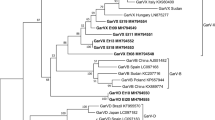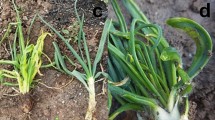Abstract
A survey identified viruses infecting garlic, leek and onion crops and wild Allium species in Greece. Virus identification was based on ELISA, immunoelectron microscopy, and occasionally on RT-PCR. Samples of cultivated Allium species were collected from five districts, whereas samples of twenty-seven wild Allium species were also collected from all over Greece. Onion yellow dwarf virus (OYDV) and Leek yellow stripe virus (LYSV) were identified in 98.5% and 83.7% of all samples, respectively, and were found in all regions. Allexiviruses were also detected in all regions and their incidence ranged from 62.5% to 70.5% (depending on region and type of allexivirus). Garlic common latent virus (GCLV) was detected in samples from Arcadia (97.6%) and Evia (18.0%) and in one field in Larissa (23.0%). Shallot latent virus (SLV) was found only in two areas (Evros and Theva) and in fields planted with imported propagative material, from Iran and China. The incidence of virus-like symptoms in leek crops ranged from 10.0% to 90.0% in different regions and fields and all symptomatic plants were found to be infected by LYSV. Onion yellow dwarf virus was only found in seven symptomatic onion samples from southern Greece. Allium ampeloprasum spp. ampeloprasum and Allium flavum, were the only wild Allium species found to be infected with LYSV. Finally Turnip mosaic virus (TuMV) was found in A. sphaerocephalon, A. guttatum, A. subhirsutum, and A. neapolitanum.
Similar content being viewed by others
References
Barg E, Lesemann D-E, Vetten HJ and Green SK (1994) Identification, partial characterisation and distribution of viruses infecting Allium crops in south and south-east Asia. Acta Horticulturae 358: 251-258
Barg E, Lesemann D-E, Vetten HJ and Green SK (1997) Viruses of Alliums and their distribution in different Allium crops and geographical regions. Acta Horticulturae 433: 607-616
Barg E (1996) Serologische und molekulargenetische Untersuchungen zur Variabilitât Allium-Arten infizierender, filamentôser Viren/vorgelegt von Erhard Barg.-Clausthal- Zellerfeld: Papierflieger, 1996. Zugl.: Gôttingen, Univ., Diss., 1996. ISBN 3-931986-40-43
Bos L, Huijberts N, Huttinga H and Maat DZ (1978a) Leek yellow stripe virus and its relationships to onion yellow dwarf virus; characterization, ecology and possible control. Netherlands Journal of Plant Pathology 84: 185-204
Bos L, Huttinga H and Maat DZ (1978b) Shallot latent virus, a new carlavirus. Netherlands Journal of Plant Pathology 84: 227-237
Gera A, Leseman DE, Cohen J, Franck A, Levy S and Salomon R (1997) The natural occurrence of turnip mosaic potyvirus in Allium ampeloprasum. Journal of Phytopathology 145: 289-293
Hillman BI and Lawrence DM (1995) Carlaviruses. In: Singh RP, Singh US, Kohmoto K (eds) Pathogenesis and Host Specificity in Plant Diseases, Histopathological, Biochemical, Genetic and Molecular Bases. Vol III: Viruses and Viroids (pp 35-50) Pergamon Press, London
Kanyuka KV, Vishnichenko VK, Levay KE, Kondrikov EV, Ryabov EV and Zavriev SK (1992) Nucleotide sequence of shallot virus X RNA reveals a 5′-proximal cistron closely related to those of the potexviruses and a unique arrangement of the 3′-proximal cistrons. Journal of General Virology 73: 2553-2560
Koch M and Salomon R (1994) Serological detection of onion yellow dwarf virus in garlic. Plant Disease 78: 785-788
Lange WH and LK Mann (1960) Fumigation controls microscopic mite attacking garlic. California Agriculture December, 1960: 9-10
Lee YW, Yamazaki S, Osaki T and Inouye T (1979) Two elongated viruses in garlic, garlic latent virus and garlic mosaic virus. Annals of the Phytopathological Society of Japan 45: 727-734
Lot H, Chovelon V, Souche S and Delecolle B (1998) Effects of onion yellow dwarf and leek yellow stripe viruses on symptomatology and yield loss of three French garlic cultivars. Plant Disease 82: 1381-1385
Paludan N (1980) Virus attack on leek: survey, diagnosis, tolerance of varieties and winterhardiness. Tidsskrift for Planteavl 84: 371-385
Razvjazkina GM (1971) Das Zwiebelmosaikvirus und seine Verbreitung im Freiland. Tagungs-Berichte der Deutschen Akademie der Landwirtschaftswissenschaften (Berlin) 115, 69-76
Salomon R and Katis NI (1996) Viruses of garlic (Allium sativum) in Greece. Abstracts of the papers presented in the 8th Panhellenic Phytopathological meeting, pp 101
Sambrook J, Fritsch EF and Maniatis T (1989) Molecular Cloning: A Laboratory Manual 2nd edn, Cold Spring Harbor University Press, Cold Spring Harbor, USA
Song SI, Song JT, Kim CH, Lee JS and Choi YD (1998) Molecular characterization of the garlic virus X genome. Journal of General Virology 79: 155-159
Stefanac Z and Plese N (1980) Turnip mosaic virus in two Mediterranean Allium species. Proceedings of the fifth Congress of the Mediterranean Phytopathological Union, Patras, Greece, 21-27 September, pp 37-38
Sumi S, Tsuneyoshi T and Furutani H (1993) Novel rod-shaped viruses isolated from garlic, Allium sativum, possessing a unique genome organization. Journal of General Virology 74: 1879-1885
Tsuneyoshi T and Sumi S (1996) Differentiation among garlic viruses in mixed infections based on RT-PCR procedures and direct tissue blotting immunoassays. Phytopathology 86: 253-259
Tsuneyoshi T, Matsumi T, Deng TC, Sako I and Sumi S (1998a) Differentiation of Allium carlaviruses isolated from different parts of the world based on the viral coat protein sequence. Archives of Virology 143: 1093-1107
Tsuneyoshi T, Matsumi T, Natsuaki KT and Sumi S (1998b) Nucleotide sequence analysis of virus isolates indicates the presence of three potyvirus species in Allium plants. Archives of Virology 143: 97-113
Van Dijk P (1991) Mite-borne virus isolates from cultivated Allium species and their classification into two new rymoviruses in the family Potyviridae. Netherlands Journal of Plant Pathology 97: 381-399
Van Dijk P (1993a) Survey and characterisation of potyviruses and their strains of Allium species. Netherlands Journal of Plant Pathology 99(suppl 2): 1-48
Van Dijk P (1993b) Carlavirus isolates from cultivated Allium species represent three viruses. Netherlands Journal of Plant Pathology 99: 233-257
Van Dijk P and van der Vlugt RAA (1994) New mite-borne virus isolates from rakkyo, shallot and wild leek species. European Journal of Plant Pathology 100: 269-277
Walkey DGA (1990) Virus diseases. In: Rabinowitch HD, Brewster JL (eds) Onion and Allied Crops. Vol 2 (pp 191-211) CRC Press, Boca Raton
Yamashita K, Sakai J and Hanada K (1996) Characterization of a new virus from garlic (Allium sativum L.), garlic mite-borne mosaic virus. Annals of the Phytopathological Society of Japan 62: 483-489
Author information
Authors and Affiliations
Corresponding author
Rights and permissions
About this article
Cite this article
Dovas, C.I., Hatziloukas, E., Salomon, R. et al. Incidence of Viruses Infecting Allium Spp. in Greece. European Journal of Plant Pathology 107, 677–684 (2001). https://doi.org/10.1023/A:1011958914573
Issue Date:
DOI: https://doi.org/10.1023/A:1011958914573




